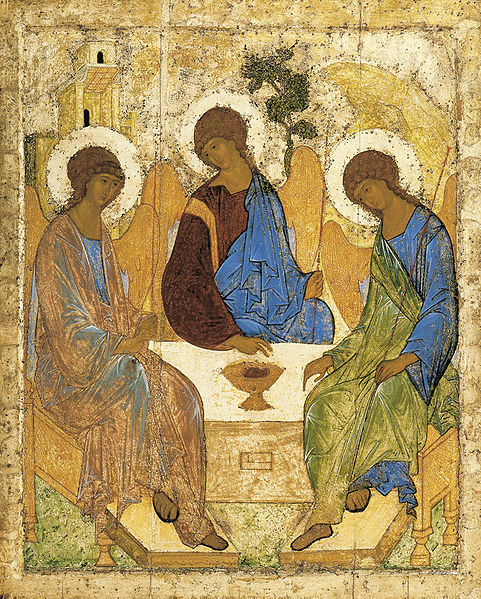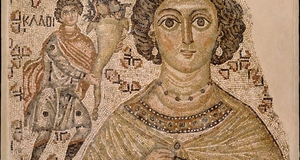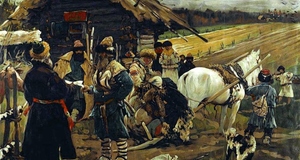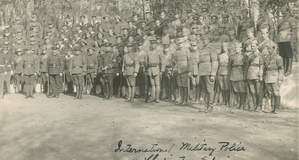Byzantine and Russian Influences in Andrei Rublev's Art
By
2011, Vol. 3 No. 02 | pg. 1/1
KEYWORDS:
Andrei Rublev (c. 1360-1430) is a mysterious figure, whose biography is not well known, although he is historically considered the best-known painter of Russian icons and frescoes. Early in his life he joined the Trinity-Sergei Lavra Monastery, becoming the pupil of Prokhor of Gorodets before moving to Andronikov Monastery, near Moscow, where he also died.1 In 1405, along with Prokhor of Gorodets, Rublev worked with Theophanes the Greek at the frescoes of the Annunciation Cathedral in the Moscow Kremlin, and some of these, namely the Annunciation, Nativity, Baptism of Christ, Transfiguration of Christ, Christ’s Entry into Jerusalem, The presentation of the Christ Child in the Temple and the Resurrection of Lazarus are attributed to Rublev. He also painted the major icons for the iconostasis of the Cathedral of Nativity in Zvenigorod (Christ Pantocrator, St. Paul, Archangel Michael). In 1408, he is to be found alongside Daniel Chorni, painting in the Dormition Cathedral in Vladimir (fresco of Last Judgment, icons such as Christ in Glory, Ascension of Christ and St. John the Baptist). Rublev’s famous icon of the Old Testament Trinity, was commissioned around 1411, in honor of St. Sergei, the founder of the Trinity-Sergei Monastery. His lasts works were done alongside Daniel Chorni, at the Trinity –Sergei Monastery and the Andronikov Monastery, which later became the Rublev Museum.2  Andrei Rublev's icon of the Trinity Andrei Rublev's icon of the TrinityThis short biography of Andrei Rublev opens the question as to the influences for his art, particularly his icons. His art has arguably different influences. The most prominent of these is the Byzantine influence, and Greek Christian art, specifically through Theophanes the Greek but also through the legacy of older Russian icon painting, particularly Kievan. The second of these is actually Russian iconography (specifically Novgorodian iconography) and Rublev’s own spiritual beliefs and monastic life, which again can be argued as being “Greek” or “Russian.” The history of Russian Orthodoxy and iconography does give us an answer to this question. When the prince of Kiev, Vladimir I (980-1015), married Anne, sister of Emperor Basil II, he also converted to Christianity, and in 988 he made Christianity the official religion of his land and people.3 Nonetheless, the culture took flight and the tradition was established not in the reign of Vladimir I but started in that of his son, Iaroslav (1015-1054), and went all through the reign of the latter’s grandson, Vladimir Monomakh (1113-1125).4 Iaroslav transformed Kiev into a Christian capital, constructing the Cathedral of St. Sophia, in addition to several other majestic churches and commissioned icons to be painted, the metropolitan of Kiev, Illarion, was appointed, and the Monastery of the Caves became the place of cultural development, from architecture to history (the Primary Chronicle was written by the monks here).5 But this Golden Age of Kievan culture was intensively borrowed from Byzantium, and thus the Greeks. Artists and architects from Constantinople built the famous churches in Kiev, most of the metropolitans were natives of Constantinople, and even the monks traced their monastic life to the tradition of Mt. Athos in Greece. In this sense, it has been argued that not only the Kievan culture, but the subsequent Russian medieval culture has “made and remade” the models of Byzantium.6 These considerations are essential, considering the fact that Rublev was not only an icon painter (and thus arguably influenced by Byzantine iconography) but also a monk. From the time of Christianization of Russia, Greek artists have constantly been employed in constructing, decorating and painting churches and icons and Orthodoxy (taken from Byzantium) became a pillar of Russian nationality.Soon enough, though, Kiev declined and principalities started arising everywhere and most of the time fought against one another in an attempt to gain more land and power, and the invasion of the Mongols only added to the fragmentation.7 Of course, these local centers of power started promoting a local culture, as well, with a limited number of patrons and sponsors.8 But one center escaped the scourge of the Mongols and the fragmentation of the rest of Russia: Novgorod. Because of its democratic self-government and fruitful trade with the northern ports of Europe, as well as with Byzantium, Novgorod was not only rich and independent but also an influential cultural center. It also helped that it was never devastated in the same way the rest of the Russian lands were by the Mongols.9 From the point of view of monasticism, Novgorod’s monasteries were strategically places on the perimeters of the city, which allowed the city to protect itself against many foreign invasions. They were also under the jurisdiction of the archbishop of Novgorod (since 1156). Monasticism was not separated from urban life, but blended in it, emphasizing and proliferating culture and religious literature.10 Traces of Byzantine influence in Novgorodian iconography exist: Russian icons borrow from the development happening in Greek art, with more individualized portraits, balancing the human and divine. Greek artists have came to Novgorod and worked there in the specific ascetic style of Byzantine art, and its overall harmony. But Novgorod was not only a crossroad of merchants and thus an absorbent of foreign influences, but also the place where a unique style in iconography appeared. The background of the icons started being colored (especially in yellow) or golden (a parallel development was taking place in the Byzantine art), active facial expression, red cheeks and lively eyes enlivened the figures. The compositions had little volume, but were brightly colored and concise, containing mostly singular figures.11 Many times, the figures are massive, with austere faces, symmetrical compositions, radiating in cinnabar red, greenish-blues, brown and violets.12In this, the first traces of national traits appear in Russian iconography, distinct developments from Byzantine art, although born from it.13 Indeed later developments in Byzantine art will continue to show its effects on Russian iconography but this will not slow down the already independent development of Russian iconography. Amidst the political instability in the land, two centers of hope arose: one was Moscow, the other was monastic spirituality and along with it iconography, which plastically represented the human ideals and the eternal Kingdom of God.14 The monastic movement aspired at the sanctification of body and spirit through ascetic struggle and inspired iconography in representing the light that illumines the saints, its source being Christ.15 Because of the new stability in the land, Moscow restored relations with Byzantium, and Greek artists came to decorate Russian churches. One of these was Theophanes, who painted in the style of Palaiologan Renaissance, a tense, expressive, full of contemplation and mystical style.16 Teophanes worked in several places, like the Church of the Transfiguration in Novgorod, and the Cathedral of the Annunciation in the Moscow Kremlin,17 using muted colors and white highlights.18 One of the influences he left on Rublev’s art is the way the draperies on the figures are made.19 At the same time, the powerful monastic movement, with its leader, Sr. Sergei of Radonezh who established a tradition of Athonite-style contemplation in the monastic life, appeared.20 He is the one who founded the Holy Trinity-St. Sergei Monastery where Andrei Rublev began his life as a monk, and he is the on that was recognized as the spiritual leader of Russia.21It is to be noted that although inspired by Greek asceticism, St. Sergei’s movement acquired clearly Russian tones and continued so, spreading through the thick forests of Russia (inexistent in Greece), extolling the toil on the soil, and sustaining the fight against the Mongols and the quest for national independence. This movement inspired Russian artists to portray flowing silhouettes, softer tones, and an overall harmony to the composition.22 These two main streams of inspiration are reflected in Andrei Rublev’s art, as well. Indeed, he genially combined the Byzantine influences with the Russian style in a harmonious composition23 that has served as a model to future generations of artists, Russian and foreign alike. His images are profound, exalted, in a silent contemplation, reflecting the hesychastic prayer of the heart, that Rublev himself must have practiced.24 Through this he became the founder and leader of the artistic movement of the XVth century Russia.25 It is remarkable that exactly the best-known icon painted by Rublev, the Old Testament Trinity, expressed exactly the core ideas of Orthodox Christianity and of the Church, which was, after all, borrowed from Byzantium: the community (both the living faithful and the dead-the saints depicted on the walls of the church) over which Chris as Pantocrator presides,26 the wholeness of the Father, Son and Holy Spirit.27 The ideas of the beauty of the Kingdom of God and of the mystery of the Incarnation are all explored in iconography. Rublev might have never got to paint those icons if the dispute between the Byzantine Orthodox Church and Iconoclasts, who considered that icons were idols, had not been ended with the defeat of the latter.28 Rublev’s serene, full-of-light paintings express the theme of the Jesus as the Light of the World and/or hope into His dominion. Moreover, the structure of the Church gave that aspiration to a spiritual life, as compared to the power that the Church later ended up being. Fulfilling this function were the monks and nuns,29 who were truly leading a spiritual life, and Rublev was one of them. The discipline and austerity characteristic of Byzantine art30 can be seen in Rublev’s clear, delineated contours, stylistic abstraction and tranquility on the saint’s faces. But the specifics of Russian style, and especially of the monastic movement of the XVth century transpires through the Old Testament Trinity that presents the perfect sacrifice of love: the Father (angel on the left, flanked by the institution as a sign of His Wisdom), full of grief but encouraging, looks toward the Son (angel in the center), who bows His head to the will of the Father, while blessing the chalice, and the Holy Spirit (angel on right, flanked by a mountain, sign of spiritual elevation), who also bows His head to the Father.31 The whole composition is circular, all the action and all the characters focusing on the center, the chalice, the Eucharist: the three angels, Abraham and Sarah running with their bread offerings towards it. The fulfillment of the prophesies, the Sacrifice of the Lamb (portrayed between Abraham and Sarah), the center of Christianity, is embodied in this icon.32 Of course, some of these themes correspond not only to the influences already mentioned above but also to the current of “theological philosophizing,” characteristic to the XVth century, when the scope of the icons goes beyond portraying saints and the Christ, to new liturgical themes that many times required special interpretation. However, overall, Rublev’s works transpire a luminosity, richness of feelings, purity and poetry that attracts to contemplation. Shadow does not seem to have a place in his paintings, so much so that Rublev’s works have a quality of transparency never achieved before. His saints seem to be generous and ready to help,33 watching you with their soul-searching glance.34 A haunting example of Rublev’s art is the Christ in the Dormition Cathedral in Zvenigorod, which is full of that lyrical spirituality, characteristic for Rublev, full of compassion, kindness,35 and godliness36. As Sergei of Radonezh did in his life, Andrei Rublev combines in his art the Christian theology and outlook with a loving regard and care for man (who is the object of Orthodox Christian interpretation).37 In conclusion, Andrei Rublev’s art was not only the peak of medieval iconography in Russia, expressing the ideals of Russian Orthodoxy and monasticism, but also created from the knowledge of previous layers of artistic developments, both Russian and Byzantine. Indeed, along with Orthodoxy, Russia borrowed the Byzantine tradition of iconography and followed these models closely, until the Mongol invasion, when only Novgorod, the only one to have escaped the destruction of the invaders, still had contacts with Byzantium and was influenced by its art, but at the same time, developed a unique Russian iconography. In addition, because of the numerous princes, with their own courts, existed during the period known as Appanage Russia (after the fall of Kievan Rus and before the rise of Muscovite Russia), local center of art and iconography developed, which in time bore little resemblance to the Byzantine canons. Rublev is born at a time when Moscow rises to power and starts uniting all the principalities in Russia under its protectorate and the intense spiritual movement of St. Sergei of Radonezh aids this trend. Thus, Rublev does have contact with the old Kievan iconography and with the Greek artists newly arrived from Byzantium, but is also under the sphere of influence of Russian iconography, which he takes to a new level, never reached before him and hardly surpassed afterwards: one that expressed hope, faith and love not only in the Kingdom of God but also available on earth, a spiritual transparency and light that penetrates the material world, an expression of a hesycasm and monasticism dedicated not only to God but also to the care of God’s subjects.
References Andreyev, Nikolai. “Pagan and Christian Elements in Old Russia.” Slavic Review 21, no. 1 (1962): 16-23. Franklin, Simon. “The Origins of Russia and Its Culture.” In Gates of Mystery: The art of Holy Russia, edited by Roderick Grierson, 27-36. Fort Worth: InterCultura, 1992. Hughes, Lindsay. “Art and Liturgy in Russia: Rublev and His Successors.” In The Cambridge History of Christianity. Vol. 5, Eastern Christianity. Cambridge: Cambridge University Press, 2006. Lazarev, Viktor Nikitich. Russian Icons: From the Twelfth to the Fifteenth Century. New York: New American Library of World Literature by arrangement with UNESCO, 1962. Meyendorff, John. “The Legacy of Beauty: Liturgy, Art and Spirituality in Russia.” In Gates of Mystery: The art of Holy Russia, edited by Roderick Grierson, 37-44. Fort Worth: InterCultura, 1992. Popova, Olga. “Medieval Russian Painting and Byzantium.” In Gates of Mystery: The art of Holy Russia, edited by Roderick Grierson, 45-59. Fort Worth: InterCultura, 1992. Riasanovsky, Nicholas V. and Steinberg, Mark D. A History of Russia. 7th ed. New York: Oxford University Press, 2005. Shalina, Irina. “The Trinity.” In Gates of Mystery: The art of Holy Russia, edited by Roderick Grierson, 114-117. Fort Worth: InterCultura, 1992. Smirnova, Engelina. “The Schools of Medieval Russian Painting.” In Gates of Mystery: The art of Holy Russia, edited by Roderick Grierson, 60-71. Fort Worth: InterCultura, 1992. 1.) Encyclopedia of Russian History, Vol 3., s.v. “Andrei Rublev.” 2.) International Dictionary of Art and Artists, Vol 1, Artists, s.v. “Andrei Rublev.” 3.) Simon Franklin, “The Origins of Russia and Its Culture,” in Gates of Mystery: The art of Holy Russia, ed. Roderick Grierson (Fort Worth: InterCultura, 1992), 29-30. 4.) Ibid., 30. For years of reign-Nicholas V. Riasanovsky and Mark D. Steinberg, A History of Russia, 7th ed. (New York: Oxford University Press, 2005), 30-35. 5.) Simon Franklin, “The Origins of Russia and Its Culture,” in Gates of Mystery: The art of Holy Russia, ed. Roderick Grierson (Fort Worth: InterCultura, 1992), 31. 6.) Ibid., 31. 7.) Nicholas V. Riasanovsky and Mark D. Steinberg, A History of Russia, 7th ed. (New York: Oxford University Press, 2005), 60-62. 8.) Simon Franklin, “The Origins of Russia and Its Culture,” in Gates of Mystery: The art of Holy Russia, ed. Roderick Grierson (Fort Worth: InterCultura, 1992), 33. 9.) Encyclopedia of Monasticism, s.v. “Andrei Rublev.” 10.) Ibid., 978 11.) Viktor Nikitich Lazarev, Russian Icons: From the Twelfth to the Fifteenth Century (New York: New American Library of World Literature by arrangement with UNESCO, 1962), 12-13. 12.) Engelina Smirnova, “The Schools of Medieval Russian Painting,” in Gates of Mystery: The art of Holy Russia, ed. Roderick Grierson (Fort Worth: InterCultura, 1992), 66. 13.) Nicholas V. Riasanovsky and Mark D. Steinberg, A History of Russia, 7th ed. (New York: Oxford University Press, 2005), 120. 14.) John Meyendorff, “The Legacy of Beauty: Liturgy, Art and Spirituality in Russia,” in Gates of Mystery: The art of Holy Russia, ed. Roderick Grierson, (Fort Worth: InterCultura, 1992), 42. 15.) Ibid., 43. 16.) Olga Popova, “Medieval Russian Painting and Byzantium,” in Gates of Mystery: The art of Holy Russia, ed. Roderick Grierson, (Fort Worth: InterCultura, 1992), 55. 17.) Ibid., 56. 18.) Lindsay Hughes, “Art and Liturgy in Russia: Rublev and his successors,” in The Cambridge History of Christianity, vol. 5, Eastern Christianity (Cambridge: Cambridge University Press, 2006), 287. 19.) International Dictionary of Art and Artists, Vol 1, Artists, s.v. “Andrei Rublev.” 20.) Encyclopedia of Monasticism, s.v. “Andrei Rublev.” 21.) Nicholas V. Riasanovsky and Mark D. Steinberg, A History of Russia, 7th ed. (New York: Oxford University Press, 2005), 112. 22.) Olga Popova, “Medieval Russian Painting and Byzantium,” in Gates of Mystery: The art of Holy Russia, ed. Roderick Grierson, (Fort Worth: InterCultura, 1992), 57. 23.) Ibid., 58. 24.) Ibid., 58. 25.) Encyclopedia of Russian History, Vol 3, s.v. “Andrei Rublev.” 26.) John Meyendorff, “The Legacy of Beauty: Liturgy, Art and Spirituality in Russia,” in Gates of Mystery: The art of Holy Russia, ed. Roderick Grierson, (Fort Worth: InterCultura, 1992), 39. 27.) Viktor Nikitich Lazarev, Russian Icons: From the Twelfth to the Fifteenth Century (New York: New American Library of World Literature by arrangement with UNESCO, 1962), 20. 28.) John Meyendorff, “The Legacy of Beauty: Liturgy, Art and Spirituality in Russia,” in Gates of Mystery: The art of Holy Russia, ed. Roderick Grierson, (Fort Worth: InterCultura, 1992), 40. 29.) Ibid., 41. 30.) Olga Popova, “Medieval Russian Painting and Byzantium,” in Gates of Mystery: The art of Holy Russia, ed. Roderick Grierson, (Fort Worth: InterCultura, 1992), 48. 31.) Viktor Nikitich Lazarev, Russian Icons: From the Twelfth to the Fifteenth Century (New York: New American Library of World Literature by arrangement with UNESCO, 1962), 21. 32.) Irina, Shalina, “The Trinity,” in Gates of Mystery: The art of Holy Russia, ed. Roderick Grierson (Fort Worth: InterCultura, 1992), 116. 33.) Viktor Nikitich Lazarev, Russian Icons: From the Twelfth to the Fifteenth Century (New York: New American Library of World Literature by arrangement with UNESCO, 1962), 20, 22. 34.) International Dictionary of Art and Artists, Vol 1, Artists, s.v. “Andrei Rublev.” 35.) Lindsay Hughes, “Art and Liturgy in Russia: Rublev and his successors,” in The Cambridge History of Christianity, vol. 5, Eastern Christianity (Cambridge: Cambridge University Press, 2006), 291. 36.) International Dictionary of Art and Artists, Vol 1, Artists, s.v. “Andrei Rublev.”. 37.) Nikolai Andreyev, “Pagan and Christian Elements in Old Russia,” Slavic Review 21, no.1 (1962): 20. Suggested Reading from Inquiries Journal
Inquiries Journal provides undergraduate and graduate students around the world a platform for the wide dissemination of academic work over a range of core disciplines. Representing the work of students from hundreds of institutions around the globe, Inquiries Journal's large database of academic articles is completely free. Learn more | Blog | Submit Latest in History |


















